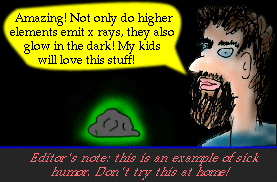Two months after this discovery, the French physicist Henri Becquerel was performing an experiment where he wrapped different elements with black-coated photographic plates to measure whether these elements could emit rays. If an element did emit a ray, it would penetrate the black coating and expose the photographic plate. Much to his surprise, Becquerel found that a few elements, including uranium, emitted energetic rays without any energy input.
 The significance of Becquerel's experiments is that some natural process was
responsible for certain elements releasing energetic x rays.
This suggested that
some elements were inherently unstable because these elements would
spontaneously release different forms of energy. This release of energetic
particles (like x rays) from the decay of unstable atoms is called
radioactivity.
The significance of Becquerel's experiments is that some natural process was
responsible for certain elements releasing energetic x rays.
This suggested that
some elements were inherently unstable because these elements would
spontaneously release different forms of energy. This release of energetic
particles (like x rays) from the decay of unstable atoms is called
radioactivity.